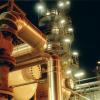|
|

Activation Energy And Rate Constant
Started by kuldeep singh, Dec 26 2012 04:44 AM
8 replies to this topic
Share this topic:
#1

Posted 26 December 2012 - 04:44 AM
How to calculate the Activation Energy and rate constant of the Chlorine forming a free radical.
Cl2 forming Cl dot.
Regards
Kuldeep
Cl2 forming Cl dot.
Regards
Kuldeep
#2

Posted 26 December 2012 - 11:15 AM
http://onlinelibrary...030105/abstract could be useful as general reference, though not free (24 h "rent" possible).
http://www2.fiu.edu/...l reactions.pdf '> http://www2.fiu.edu/...l reactions.pdf is understood to state activation energy = +243 kJ/ mol Cl2 (gas), concerning its dissociation into free radicals Cl. , same as bond enthalpy of Cl2 (gas). See pages 5-6, chlorination.
http://jcp.aip.org/r...isAuthorized=no '> http://jcp.aip.org/r...isAuthorized=no concerns Cl2 - Ar mixture (1:5) under high temperatures and shock waves (??); yet activation energy of Cl2 dissociation is not far from above value.
Bond enthalpy of Cl2 (gas) has some variation (239-243 kJ/mol) depending on source.
Rate constant A of Arrhenius equation has not been found, first mentioned reference could be useful for it.
http://www2.fiu.edu/...l reactions.pdf '> http://www2.fiu.edu/...l reactions.pdf is understood to state activation energy = +243 kJ/ mol Cl2 (gas), concerning its dissociation into free radicals Cl. , same as bond enthalpy of Cl2 (gas). See pages 5-6, chlorination.
http://jcp.aip.org/r...isAuthorized=no '> http://jcp.aip.org/r...isAuthorized=no concerns Cl2 - Ar mixture (1:5) under high temperatures and shock waves (??); yet activation energy of Cl2 dissociation is not far from above value.
Bond enthalpy of Cl2 (gas) has some variation (239-243 kJ/mol) depending on source.
Rate constant A of Arrhenius equation has not been found, first mentioned reference could be useful for it.
#3

Posted 26 December 2012 - 10:46 PM
Dear Sir
The same thing i found out on google but the problem is different.
Regards
Kuldeep
The same thing i found out on google but the problem is different.
Regards
Kuldeep
#4

Posted 27 December 2012 - 05:19 AM
Can you explain in more detail, so that some member could help?
A clarification probably useful: Energy of activation and bond enthalpy (and heat of reaction) are not generally same. But second web reference of post No 2, box "Activation Energies for Chlorination of Methane" says following.
When using enthalpy values (ΔHo) the term for the difference in energy between starting material and the transition state is the energy of activation (Eact)...........
Step 1 Chain initiation Cl2-->2Cl. Eact=+243 kJmol-1 .
Look also at box "Chlorination" below the mentioned one (page 5).
Comments from others welcomed too.
A clarification probably useful: Energy of activation and bond enthalpy (and heat of reaction) are not generally same. But second web reference of post No 2, box "Activation Energies for Chlorination of Methane" says following.
When using enthalpy values (ΔHo) the term for the difference in energy between starting material and the transition state is the energy of activation (Eact)...........
Step 1 Chain initiation Cl2-->2Cl. Eact=+243 kJmol-1 .
Look also at box "Chlorination" below the mentioned one (page 5).
Comments from others welcomed too.
Edited by kkala, 27 December 2012 - 05:39 AM.
#5

Posted 27 December 2012 - 09:24 AM
Are you talking about in an aqueous solution? If so, that would just be the dissociation energy
#6

Posted 28 December 2012 - 02:35 AM
Dear Sir
the chlorine forming a free radical is a reversible reaction. i want to find out the rate constant of forward as well as backward reaction with respect to temperature and Eo of the reaction.
Regards
Kuldeep
the chlorine forming a free radical is a reversible reaction. i want to find out the rate constant of forward as well as backward reaction with respect to temperature and Eo of the reaction.
Regards
Kuldeep
#7

Posted 28 December 2012 - 06:42 AM
The only additional info found is that "The degree of thermal dissociation of Cl2 + 243 kJ --><-- 2Cl is 2.07 × 10–4 percent at 1000°K and 0.909 percent at 2500°K", http://encyclopedia2.thefreedictionary.com/Chlorine+gas. This is probably at 1 Atma total pressure, but not clarified.
Above dissociation of Cl2 molecule (homolytical split) into two identical free radicals (atoms) occurs in gaseous state (by heat or UV light).
I think activation energy for Cl2-->2Cl. (rate constant k1) is 239-243 kJ/mol as above. If rate constant of reverse reaction is k2, equilibrium constant is equal to k1/k2.
Above dissociation of Cl2 molecule (homolytical split) into two identical free radicals (atoms) occurs in gaseous state (by heat or UV light).
I think activation energy for Cl2-->2Cl. (rate constant k1) is 239-243 kJ/mol as above. If rate constant of reverse reaction is k2, equilibrium constant is equal to k1/k2.
Edited by kkala, 28 December 2012 - 06:51 AM.
#8

Posted 29 December 2012 - 12:24 AM
thank you sir for your great help and support. does anyone tell me the good software of molecular modelling...
Regards
Kuldeep
Regards
Kuldeep
#9

Posted 07 January 2013 - 03:37 AM
where do i find a good software of molecular modelling
Regards
Kuldeep
Regards
Kuldeep
Similar Topics
Centrifugal Pump In Recycle Mode: Constant Power Consumption But FluctStarted by Guest_Kakka_* , 23 Jan 2025 |
|

|
||
How To Estimate The Circulation Rate For Amdea (Mdea 45Wt + Pz 5Wt) BeStarted by Guest_tokotof_* , 29 Nov 2024 |
|

|
||
Subcooled Reflux And Energy UsageStarted by Guest_jango_* , 20 Dec 2024 |
|

|
||
Psv Release Rate Vs TimeStarted by Guest_stu_* , 30 Nov 2024 |
|

|
||
Relieving Flow Rate In Terms Of Air EquivalentStarted by Guest_go-fish_* , 21 Nov 2024 |
|

|

 FB
FB








